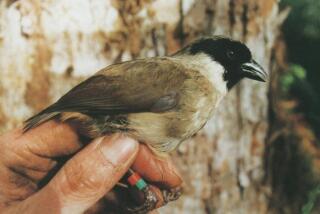RHINOS Endangered Species by Malcolm Penny (Facts...
- Share via
RHINOS Endangered Species by Malcolm Penny (Facts On File: $19.95)
Will this book be read, one is moved to ask, by the poachers in Zambia, or by North Yemenese men, who will pay up to $30,000 for a knife handle made of rhino horn? After all, what can pacific Americans do about vanishing whales, tigers and elephants, much less rhinoceroses, which mostly populate nations that are not aligned with the United States? As the author himself admits, many current rhino conservation efforts are misguided. By sending radios and guns to game wardens, he writes, some wildlife groups are merely fomenting a “bush war” against poachers rather than solving the root problems: The enduring importance of rhino horns in Oriental medicine and African culture and the considerable damage rhinos do to agricultural crops, which motivates landowners to help poachers. Because there seems so little we can do, our regret over vanishing species can easily turn to cynicism: Perhaps species extinction is a “natural” process, whether caused by an ice age or by man.
The solutions offered by zoologist Malcolm Penny aren’t promising enough to dampen this pessimism: A stable government is necessary, he writes, to ensure that rhinos are protected and to practice population control so rhinos don’t destroy crops, but how can one ensure such a government in volatile Africa and South Asia? Penny turns us around, however, with thoughtful optimism and quirky descriptions of these weighty and clumsy-looking creatures. And so, by the end of this book, we think seriously about contributing to some of the wildlife funds Penny lists, if mostly for romantic reasons. Rhinos, Penny writes, look like sheathed gladiators (the Germans called the Indian variety “tank rhinoceroses”) but in one of the ironies of nature, they are actually shy and docile. They feed on leaves, twigs, tree seedlings and fruit and the only fiery passions they have are territorial (they’re fond of crashing through brush and trees to leave their mark) and romantic (black rhinos mate for 20-35 minutes at a time, several times a day).
More to Read
Sign up for our Book Club newsletter
Get the latest news, events and more from the Los Angeles Times Book Club, and help us get L.A. reading and talking.
You may occasionally receive promotional content from the Los Angeles Times.







